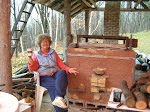
The end of 2008 brings me to the halfway point in my Journey Workshop and I have decided to review my progress so far. The pot pics posted are from the last firing of 2008. Some successful, mostly not, but getting better.
Since starting my journey in July, I can see a decided change for the better in my work. I attribute this directly to the fact that Steven's superb critical eye and hsi helpful suggstions are never far from my mind. I find myself continually asking, "Is this the best that I can do?"
I find that I am working on several themes - the handbuilt appliqued pots, oval covered pots, bowls, teapots and cups and trying to tie them together into a more unified look - one of my goals for this year long journey workshop. A unified look is something that is hard for me to achieve as I love trying new ideas, especially decorating ones.
There have been many other lessons learned from Steven as well.
1. I try to examine all the details, front and back, top and bottom. As Steven says , "God is in the details". Steven has an incredible eye for detail. Nothing is too much trouble for him. When I complain about something being difficult to do, such as a tedious decoration or a difficult handbuilding section, he says, "But that's not the point. " I continually try to remind myself of that and try not to take shortcuts.


A good example is his view that a pot is a 3-D form so decoration should be on all sides. It does not have to be a lot - just something that ties in and catches your attention.
2. He emphasizes making lots of sketches of pots. Although I had already been doing this, I am doing this even more now and this has been invaluable - even if I draw the same form over and over. I may then set it aside for several days/weeks. When I come back to it, often forms are refined and new ideas developed.
3. Focus on the rim and foot. Steven says those are like punctuation marks on a pot. One should not overwhelm the other, unless one deliberately intends to, for the sake of the design. One thing that I have noticed with potters who have had formal training is the strong feet and rims that their pots have. Self taught potters tend to have especially weak feet. I have been trying to makes stronger rims and feet - the bowl pictured below has a stronger rim than I used to make.

4. Handles. Although I had tried over the years to make handles pulled off the cup I had never succeeded in making those my standard handle. Several years ago I had ordered the DVD from Tony Clennel on making handles and that helped a lot. It wasn't until I finally made myself try them again at Steven's suggestion at Centre Street Clay that I am finally beginning to get comfortable making them.

I still have a long way to go, but as Steven says, "They are miles better than they were before." Yet I had thought my handles before were not bad. Again that is another sure way to often spot whether a potter is professionally trained or self taught (and that's me mostly).
5. Asking myself, "What do I like, not like about the pot." Steven usually starts a critique with - "Well what do you think?" What he thinks is sometimes different and together it makes for an in depth look at the pot.

Verbalizing my opinions to him during our consultations has helped me really think about my pots and to remember my ideas. I feel this has directly led to an improvement in the overall look in my pottery.
7. Emphasis on form - is the total in balance, resulting in a pleasing shape? What is the pot saying to you? What do handles, knobs, decorations add to the pot? In the small covered jar the knob adds elegance, but the copper red glaze on the lid is off centre (it is hard to see in the pic) and so very distracting from the overall design and central placement of the knob, which is more formal. This ties in to point #5 below on how glazes empathize the form - rightly or wrongly - wrongly (to me at least)in this case.)

5. How glazes emphasize the form, bring out the best features in a pot. As well a sprayed pot should not necessarily look sprayed. Glazing is still a major weak point with me. You can see from the pics posted here that my pots still mostly look sprayed - no subtlety there. I hate glazing! You can see that the painter's water jar and brush rest on right would have been more attractive without such a strong central blue area - I need to think about my spraying more carefully. As well I have difficulty with color combinations - I need to try to better visualize the final result.
Although my work is still all over the map in terms of style, glazes etc, I am slowly getting to a more narrow focus - to achieving that unified look. Thank you Steven for a marvellous, inspiring 5 months and there are 6 more months to go!











No comments:
Post a Comment